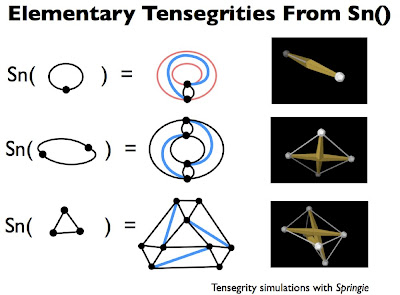The assembly procedure does not care what we might have drawn on the faces of the edge-rhombs, and, since many structures and machines can be represented as truchet tiles drawn on edge rhombs, an undip word is also a step-by-step guide to the assembly of any such structure or machine.
In the following I'll assume the reader is familiar with the procedure of reading an undip word to weave twogs into baskets as described in Make a Basket from a Word.
Edge-rhombs are topological objects that can be stretched in any way we wish, but it will forestall confusion if we idealize edge-rhombs as the rhombic shape created by joining two equilateral triangles at a common edge, and further assume that an edge of our primal map (the triangulation) forms the longer diagonal. Therefore, an edge of the dual map (a cubic or trivalent map) forms the short diagonal.
TWOGS through the state of play "uun—"
In order to represent the "assembly" of a twog weaving, I have made a set of paper edge-rhombs with the short diagonal marked in each of three colors. In the photographs below, green is the "photon color" and blue and pink are the "energy colors."
An undip word gains a half edge for free at the beginning of the word, and another half edge for free at the end of the word (the last being the other half of the first.) These moves are encoded, not by a letter, but simply by the fact that the word begins and ends. In reassembling edge-rhombs, we show this peculiar opening move by playing just half of an edge-rhomb (i.e., from an edge-rhomb sliced in two along its longer diagonal.)
The first letter is either a u or n, let's say u. That says, "emit a photon to the left, and then build on to the right." The photon edge will not be completed until later when it gets "absorbed." We show the state of incompletion by placing just half an edge-rhomb on the photon side while building on with a full edge-rhomb on the electron side. If our edge-rhombs have been decorated as truchet tiles, we can now physically build everything that is fully drawn at this state of play. All else must wait until more tiles are added or joined.
Below, edge-rhombs decorated as twogs are carried through to the state-of-play uun—.
Suppose the next letter is d. One can visualize how a half a photon rhomb will be added on the left side of the last played rhomb and then joined to another half photon rhomb already in the work.
That's pretty much all there is to reassembling a map from an undip word that codes it.
Below are four tensegrity patterns also taken through to the state of play uun—.
ZIG-ZAG TENSEGRITY through "uun—"
CIRCUIT TENSEGRITY through "uun—"
STAR TENSEGRITY through "uun—"
DIAMOND TENSEGRITY through "uun—"


